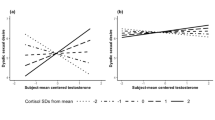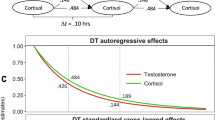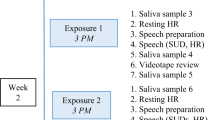Abstract
In recent decades, testosterone challenge research examining the effects of testosterone on human neuropsychological behaviors has rapidly grown with the development of a single-dose transdermal testosterone administration paradigm. However, the optimal time-lag between testosterone administration and behavioral measurement is not unified, partly hindering causal understanding of the “testosterone effect”. The present study aimed to investigate the optimal time-lag through LC-MS/MS-based salivary profiles of ten biomarkers among healthy males following administration of different doses of transdermal testosterone (i.e., 450- and 150-mg [Androgel®]). Results revealed that testosterone administration significantly increased salivary testosterone levels, reaching maximum levels 2 hours after 450-mg testosterone administration and 1 hour after 150-mg testosterone administration, respectively. Salivary androstenedione and DHEA increased synchronously with testosterone following administration. Moreover, the ratios of testosterone to androstenedione, DHEA, estradiol, and of androstenedione to estrone significantly elevated 1 hour after testosterone administration. In contrast, salivary cortisol and cortisone were decreased over time due to circadian rhythm rather than testosterone administration. Consistent with previous serum studies, the present salivary findings recommended 1-hour post testosterone administration as the optimal time-lag to measure the effects of testosterone on human behaviors in transdermal testosterone challenge research.



Similar content being viewed by others
Data Availability
The raw data collected and analysed during the present study are available from the corresponding author upon request
References
Blom T, Ojanotkoharri A, Laine M, Huhtaniemi I (1993) Metabolism of progesterone and testosterone in human parotid and submandibular salivary-glands in vitro. J Steroid Biochem Mol Biol 44(1):69–76. https://doi.org/10.1016/0960-0760(93)90153-N
Bos PA, Panksepp J, Bluthe RM, van Honk J (2012) Acute effects of steroid hormones and neuropeptides on human social-emotional behavior: a review of single administration studies. Front Neuroendocrinol 33(1):17–35. https://doi.org/10.1016/j.yfrne.2011.01.002
Carre JM, Geniole SN, Ortiz TL, Bird BM, Videto A, Bonin PL (2017) Exogenous testosterone rapidly increases aggressive behavior in dominant and impulsive men. Biol Psychiatry 82(4):249–256. https://doi.org/10.1016/j.biopsych.2016.06.009
Carre JM, Ortiz TL, Labine B, Moreau BJ, Viding E, Neumann CS et al (2015) Digit ratio (2D:4D) and psychopathic traits moderate the effect of exogenous testosterone on socio-cognitive processes in men. Psychoneuroendocrinology 62:319–326. https://doi.org/10.1016/j.psyneuen.2015.08.023
Carre JM, Robinson BA (2020) Testosterone administration in human social neuroendocrinology: Past, present, and future. Horm Behav 122:104754. https://doi.org/10.1016/j.yhbeh.2020.104754
de Wit AE, Bosker FJ, Giltay EJ, de Kloet CS, Roelofs K, van Pelt J et al (2018) Testosterone in human studies: Modest associations between plasma and salivary measurements. Andrologia 50(1):e12779. https://doi.org/10.1111/and.12779
Eisenegger C, Haushofer J, Fehr E (2011) The role of testosterone in social interaction. Trends Cogn Sci 15(6):263–271. https://doi.org/10.1016/j.tics.2011.04.008
Eisenegger C, von Eckardstein A, Fehr E, von Eckardstein S (2013) Pharmacokinetics of testosterone and estradiol gel preparations in healthy young men. Psychoneuroendocrinology 38(2):171–178. https://doi.org/10.1016/j.psyneuen.2012.05.018
Filova B, Malinova M, Babickova J, Tothova L, Ostatnikova D, Celec P et al (2015) Effects of testosterone and estradiol on anxiety and depressive-like behavior via a non-genomic pathway. Neurosci Bull 31(3):288–296. https://doi.org/10.1007/s12264-014-1510-8
Foradori CD, Weiser MJ, Handa RJ (2008) Non-genomic actions of androgens. Front Neuroendocrinol 29(2):169–181. https://doi.org/10.1016/j.yfrne.2007.10.005
Geniole SN, Carre JM (2018) Human social neuroendocrinology: Review of the rapid effects of testosterone. Horm Behav 104:192–205. https://doi.org/10.1016/j.yhbeh.2018.06.001
Genzen JR, La’ulu SL, Wyness SP, Scholes KL, Signorelli HN, Greer RW (2019) Identifying and eliminating laboratory contamination by topical testosterone therapeutics. Clin Chem 65(1):67–73. https://doi.org/10.1373/clinchem.2018.294538
Goetz SM, Tang L, Thomason ME, Diamond MP, Hariri AR, Carre JM (2014) Testosterone rapidly increases neural reactivity to threat in healthy men: a novel two-step pharmacological challenge paradigm. Biol Psychiatry 76(4):324–331. https://doi.org/10.1016/j.biopsych.2014.01.016
Granger DA, Shirtcliff EA, Booth A, Kivlighan KT, Schwartz EB (2004) The "trouble" with salivary testosterone. Psychoneuroendocrinology 29(10):1229–1240. https://doi.org/10.1016/j.psyneuen.2004.02.005
Gray PB, Straftis AA, Bird BM, McHale TS, Zilioli S (2020) Human reproductive behavior, life history, and the Challenge Hypothesis: A 30-year review, retrospective and future directions. Horm Behav 123:104530. https://doi.org/10.1016/j.yhbeh.2019.04.017
Hansen S, McAuliffe J, Goldfarb B, Carre JM (2017) Testosterone influences volitional, but not reflexive orienting of attention in human males. Physiol Behav 175:82–87. https://doi.org/10.1016/j.physbeh.2017.03.032
McCall C, Singer T (2012) The animal and human neuroendocrinology of social cognition, motivation and behavior. Nat Neurosci 15(5):681–688. https://doi.org/10.1038/nn.3084
Nave G, Nadler A, Zava D, Camerer C (2017) Single-dose testosterone administration impairs cognitive reflection in men. Psychol Sci 28(10):1398–1407. https://doi.org/10.1177/0956797617709592
Polet M, De Wilde L, Van Renterghem P, Van Gansbeke W, Van Eenoo P (2018) Potential of saliva steroid profiling for the detection of endogenous steroid abuse: Reference thresholds for oral fluid steroid concentrations and ratios. Anal Chim Acta 999:1–12. https://doi.org/10.1016/j.aca.2017.11.015
Ponzetto F, Mehl F, Boccard J, Baume N, Rudaz S, Saugy M et al (2016) Longitudinal monitoring of endogenous steroids in human serum by UHPLC-MS/MS as a tool to detect testosterone abuse in sports. Anal Bioanal Chem 408(3):705–719. https://doi.org/10.1007/s00216-015-9185-1
Prasad S, Lassetter B, Welker KM, Mehta PH (2019) Unstable correspondence between salivary testosterone measured with enzyme immunoassays and tandem mass spectrometry. Psychoneuroendocrinology 109:04373. https://doi.org/10.1016/j.psyneuen.2019.104373
Puiu AA, Radke S, Votinov M, Habel U, Herpertz-Dahlmann B, Turetsky B et al (2019) Serum testosterone and cortisol concentrations after single-dose administration of 100-mg transdermal testosterone in healthy men. Front Pharmacol 10:1397. https://doi.org/10.3389/fphar.2019.01397
Schonfelder M, Hofmann H, Anielski P, Thieme D, Oberhoffer R, Michna H (2011) Gene expression profiling in human whole blood samples after controlled testosterone application and exercise. Drug Test Anal 3(10):652–660. https://doi.org/10.1002/dta.360
Thieme D, Rautenberg C, Grosse J, Schoenfelder M (2013) Significant increase of salivary testosterone levels after single therapeutic transdermal administration of testosterone: suitability as a potential screening parameter in doping control. Drug Test Anal 5(11–12):819–825. https://doi.org/10.1002/dta.1536
Tuiten A, Van Honk J, Koppeschaar H, Bernaards C, Thijssen J, Verbaten R (2000) Time course of effects of testosterone administration on sexual arousal in women. Arch Gen Psychiatry 57(2):149–153; Discussion: 155–146. https://doi.org/10.1001/archpsyc.57.2.149
Welling LL, Moreau BJ, Bird BM, Hansen S, Carre JM (2016) Exogenous testosterone increases men's perceptions of their own physical dominance. Psychoneuroendocrinology 64:136–142. https://doi.org/10.1016/j.psyneuen.2015.11.016
Wingfield JC, Hegner RE, Dufty AM, Ball GF (1990) The challenge hypothesis-theoretical implications for patterns of testosterone secretion, mating systems, and breeding strategies. Am Nat 136(6):829–846. https://doi.org/10.1086/285134
Wood P (2009) Salivary steroid assays - research or routine? Ann Clin Biochem 46(3):183–196. https://doi.org/10.1258/acb.2008.008208
Wu Y, Clark L, Zilioli S, Eisenegger C, Gillan CM, Deng H et al (2018) Single dose testosterone administration modulates emotional reactivity and counterfactual choice in healthy males. Psychoneuroendocrinology 90:127–133. https://doi.org/10.1016/j.psyneuen.2018.02.018
Wu Y, Liao J, Zilioli S, Wu Y, Deng H, Li H et al (2019) Testosterone administration increases social discounting in healthy males. Psychoneuroendocrinology 108:127–134. https://doi.org/10.1016/j.psyneuen.2019.06.013
Wu Y, Shen B, Liao J, Li Y, Zilioli S, Li H (2020a) Single dose testosterone administration increases impulsivity in the intertemporal choice task among healthy males. Horm Behav 118:104634. https://doi.org/10.1016/j.yhbeh.2019.104634
Wu Y, Wu Y, Deng J, Chu L, Yang H, Wang W et al (2020b) Screening and identification of salivary biomarkers for assessing the effects of exogenous testosterone administration on HPG and HPA axes and ECS. Steroids 158:108604. https://doi.org/10.1016/j.steroids.2020.108604
Wu Y, Zhang Y, Ou J, Hu Y, Zilioli S (2020c) Exogenous testosterone increases the audience effect in healthy males: evidence for the social status hypothesis. Proc Biol Sci 287(1931):0976. https://doi.org/10.1098/rspb.2020.0976
Wudy SA, Schuler G, Sanchez-Guijo A, Hartmann MF (2018) The art of measuring steroids: Principles and practice of current hormonal steroid analysis. J Steroid Biochem Mol Biol 179:88–103. https://doi.org/10.1016/j.jsbmb.2017.09.003
Zak PJ, Kurzban R, Ahmadi S, Swerdloff RS, Park J, Efremidze L et al (2009) Testosterone administration decreases generosity in the ultimatum game. PLoS ONE 4(12):e8330. https://doi.org/10.1371/journal.pone.0008330
Zilioli S, Bird BM (2017) Functional significance of men's testosterone reactivity to social stimuli. Front Neuroendocrinol 47:1–18. https://doi.org/10.1016/j.yfrne.2017.06.002
Acknowledgements
This work was sponsored by the National Natural Science Foundation of China (31800952 and 31600923), Jiangsu Provincial Social Science Foundation (19JYA001) and the Fundamental Research Funds for the Southeast University (2242019s10024, 3218006405). The funding sources had no further role in the study design, data collection, analysis, interpretation, and decision to submit this manuscript for publication.
Author information
Authors and Affiliations
Contributions
The study was designed by Yan Wu, Yin Wu and Huihua Deng. Saliva samples were collected by Yin Wu and then were determined by Yan Wu, Liuxi Chu, Haoran Yang and Wei Wang using a developed LC-MS/MS method. The samples data were analyzed by Yan Wu, Yin Wu and Huihua Deng. The first version of the manuscript was written by Yan Wu and the draft was reviewed and edited by Huihua Deng and Yin Wu. All authors approved the final version of the manuscript for submission.
Corresponding author
Ethics declarations
Conflict of Interest
None interest conflict need to be declared.
Additional information
Publisher's Note
Springer Nature remains neutral with regard to jurisdictional claims in published maps and institutional affiliations.
Supplementary Information
Below is the link to the electronic supplementary material.
Rights and permissions
Springer Nature or its licensor (e.g. a society or other partner) holds exclusive rights to this article under a publishing agreement with the author(s) or other rightsholder(s); author self-archiving of the accepted manuscript version of this article is solely governed by the terms of such publishing agreement and applicable law.
About this article
Cite this article
Wu, Y., Wu, Y., Chu, L. et al. The Optimal Time-lag for Testosterone Challenge Research Based on Salivary Profiles Following Different Doses of Transdermal Testosterone Administrations. J Mol Neurosci 73, 297–306 (2023). https://doi.org/10.1007/s12031-023-02118-x
Received:
Accepted:
Published:
Issue Date:
DOI: https://doi.org/10.1007/s12031-023-02118-x




